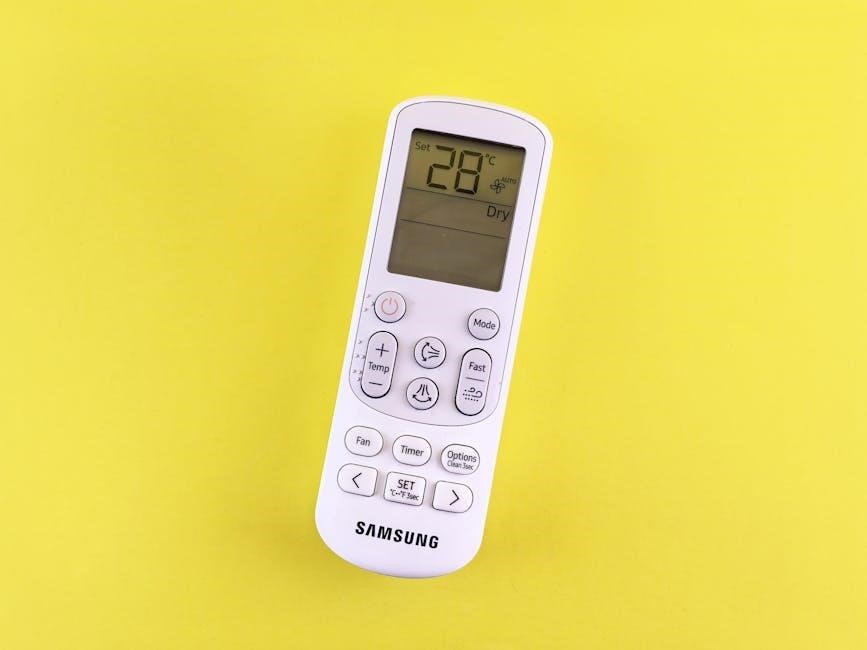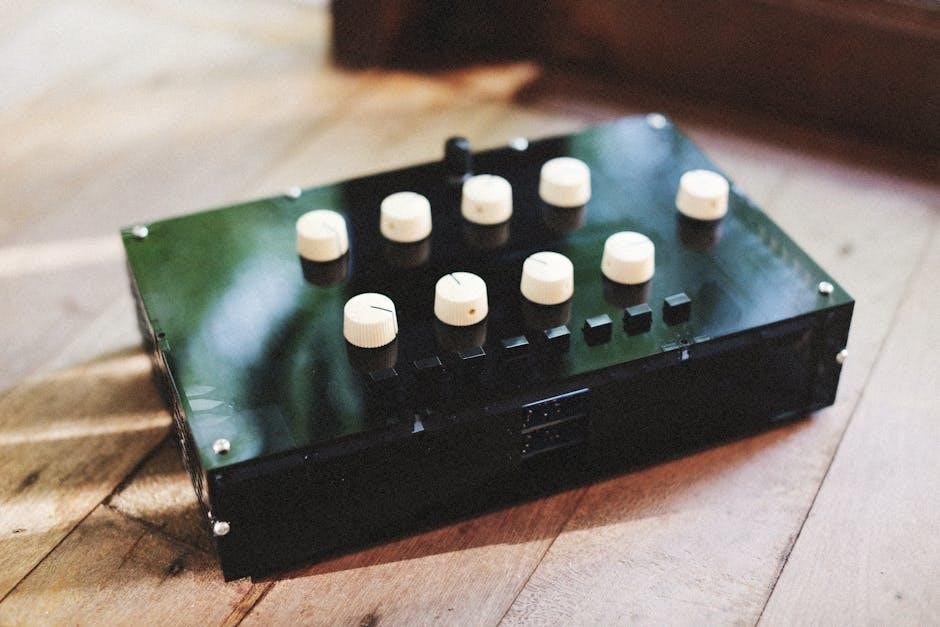Johnson Controls Thermostat Manual: A Comprehensive Guide
This manual details Johnson Controls thermostats, including pneumatic-to-digital conversions like the WT-4000 series. It provides guidance for operation, programming, and troubleshooting modern HVAC systems.
Johnson Controls thermostats represent a long-standing commitment to building efficiency and comfort. For decades, they’ve been a trusted name in both residential and commercial HVAC control systems. This manual serves as a comprehensive resource for understanding and operating a wide range of Johnson Controls thermostat models, from traditional pneumatic systems to cutting-edge digital programmable units.
The company’s evolution reflects the changing needs of building management. Recognizing the prevalence of older pneumatic systems, Johnson Controls now offers solutions like the WT-4000 series, designed for seamless pneumatic-to-digital conversion. This allows integration with modern building automation systems and unlocks advanced control features. Whether you’re a homeowner, facility manager, or HVAC technician, this guide will equip you with the knowledge to maximize the performance and energy savings of your Johnson Controls thermostat.
Understanding Different Johnson Controls Thermostat Models
Johnson Controls offers a diverse portfolio of thermostats tailored to various needs and system complexities. Key series include the WT-4000, specifically engineered for converting pneumatic HVAC systems to digital control, bridging older infrastructure with modern technology. The NX8 series provides reliable, programmable functionality for residential and light commercial applications, offering customizable schedules for energy efficiency.
For more advanced control, the APX series delivers sophisticated programming capabilities and features, ideal for larger buildings and demanding environments. Understanding the distinctions between these models is crucial for proper operation and maximizing benefits. Each series boasts unique features, programming interfaces, and compatibility levels. This manual will delve into the specifics of each, helping you identify your model and access the relevant instructions for optimal performance and troubleshooting. Choosing the right model ensures effective temperature management and cost savings.
WT-4000 Series: Pneumatic to Digital Conversion

The WT-4000 series represents a significant advancement in HVAC system modernization, facilitating the conversion of older pneumatic room control systems to digital. This series enables seamless communication between legacy pneumatic devices and contemporary digital building automation systems. This conversion unlocks benefits like improved energy management, enhanced control capabilities, and remote access possibilities.
Installation typically involves replacing existing pneumatic thermostats with WT-4000 units and connecting them to the building’s digital network. Careful attention to wiring and configuration is essential for proper operation. The WT-4000 effectively translates pneumatic signals into digital data, allowing integration with building management systems (BMS). This manual provides detailed guidance on the conversion process, including wiring diagrams, setup procedures, and troubleshooting tips specific to the WT-4000 series, ensuring a smooth transition to a more efficient and controllable HVAC system.
NX8 Series: Programmable Thermostats
The Johnson Controls NX8 series offers a versatile range of programmable thermostats designed for both residential and light commercial applications. These thermostats provide users with precise temperature control and energy-saving scheduling options. The NX8 series boasts a user-friendly interface, making it easy to set up and adjust temperature preferences according to occupancy patterns.
Key features include multiple programmable periods per day, allowing for customized comfort settings. Users can create unique schedules for weekdays, weekends, and even specific days of the week. The NX8 series also supports various system types, including conventional heating and cooling, heat pumps, and multi-stage systems. This manual details the programming procedures, operational modes, and troubleshooting steps specific to the NX8 series, empowering users to optimize their HVAC system for maximum comfort and efficiency. Detailed wiring diagrams are also included for proper installation.
APX Series: Advanced Programmable Thermostats
The Johnson Controls APX series represents a leap forward in programmable thermostat technology, offering advanced features and enhanced control for optimal comfort and energy management. These thermostats are designed for more complex HVAC systems and provide a higher level of customization than the NX8 series. The APX series boasts a large, high-resolution display and intuitive navigation, simplifying programming and operation.
Beyond standard scheduling, the APX series supports features like demand response, occupancy sensing, and remote access via mobile app. Users can monitor and adjust their HVAC system from anywhere with an internet connection. This manual provides detailed instructions on utilizing these advanced features, including setting up remote access, configuring demand response settings, and interpreting system diagnostics. Wiring diagrams specific to the APX series are included, along with troubleshooting guidance for common issues. The APX series is ideal for users seeking maximum control and energy savings;

Basic Thermostat Operation
Understanding the fundamental operation of your Johnson Controls thermostat is crucial for maintaining a comfortable and efficient environment. Most models feature a clear display indicating the current room temperature and the setpoint temperature. The primary functions revolve around adjusting the setpoint – the desired temperature – using up and down arrow buttons. These adjustments initiate heating or cooling cycles as needed to maintain the set temperature.
A key aspect of basic operation involves selecting the system mode: Heat, Cool, or Auto. ‘Heat’ activates the heating system when the room temperature falls below the setpoint. ‘Cool’ activates the cooling system when the temperature rises above it. ‘Auto’ automatically switches between heating and cooling to maintain the setpoint. Additionally, the fan can be set to ‘Auto’ (runs only during heating/cooling) or ‘On’ (runs continuously). Familiarizing yourself with these core functions will allow you to effectively control your indoor climate.

Powering On and Initial Setup
Upon initial installation or after a power outage, your Johnson Controls thermostat requires a brief setup process. For battery-powered models, ensure fresh batteries are installed correctly, observing the polarity markings. For hardwired thermostats, verify the power switch to the HVAC system is in the ‘on’ position. The thermostat should power on automatically, displaying a welcome screen or prompting for initial configuration.
The initial setup typically involves setting the date and time. Some advanced models may also ask for your zip code to access local weather data for optimized performance. Carefully follow the on-screen prompts, using the thermostat’s buttons to navigate and make selections. It’s important to accurately configure these settings as they impact scheduling and other automated features. Refer to the specific model’s documentation for detailed instructions, as the setup process can vary slightly between series.
Setting the Temperature
Adjusting the temperature on your Johnson Controls thermostat is typically straightforward. Most models utilize up and down arrow buttons, or a rotary dial, to increase or decrease the desired setpoint. The current room temperature is usually displayed prominently on the screen, alongside the set temperature. Observe the difference between these values to understand if the heating or cooling system is actively working.

For programmable thermostats (NX8 & APX series), ensure you are adjusting the temperature for the correct period within the current schedule. Some models offer a ‘Hold’ function, allowing you to temporarily override the programmed schedule and maintain a constant temperature. Pay attention to the displayed mode – Heat, Cool, or Auto – as this dictates whether the thermostat will activate heating or cooling to reach the setpoint. Precise temperature control contributes to comfort and energy efficiency.
Changing Between Heat, Cool, and Auto Modes
Your Johnson Controls thermostat offers three primary operating modes: Heat, Cool, and Auto. Switching between these modes is crucial for year-round comfort and efficient HVAC operation. The ‘Heat’ mode activates the heating system when the room temperature falls below the setpoint. Conversely, ‘Cool’ mode activates the cooling system when the temperature rises above the setpoint.
‘Auto’ mode intelligently switches between heating and cooling to maintain the desired temperature, based on both indoor and outdoor conditions. Typically, a dedicated ‘Mode’ button cycles through these options. The currently selected mode is clearly indicated on the thermostat’s display. Ensure the correct mode is selected based on the season and your comfort preferences. Incorrect mode selection can lead to inefficient energy usage or an uncomfortable indoor environment. Refer to your specific model’s display for visual cues.
Fan Control: Auto and On Settings

Johnson Controls thermostats provide control over the blower fan, offering both ‘Auto’ and ‘On’ settings. The ‘Auto’ setting operates the fan only during heating or cooling cycles, providing efficient airflow when needed. This is generally the recommended setting for optimal energy conservation and consistent temperature distribution.
Selecting ‘On’ forces the fan to run continuously, regardless of whether heating or cooling is active. This can improve air circulation and even out temperature variations throughout the space, but it consumes more energy. Continuous fan operation also aids in air filtration. The fan mode is usually adjusted via a dedicated ‘Fan’ button on the thermostat. The display will indicate the current setting. Consider using ‘On’ mode during periods of high humidity or when enhanced air purification is desired, but remember the increased energy consumption.
Programming Your Johnson Controls Thermostat
Programming your Johnson Controls thermostat – particularly NX8 and APX series models – allows for customized temperature schedules, maximizing comfort and energy savings. Access the programming mode typically through a ‘Menu’ or ‘Program’ button on the thermostat interface. You’ll then navigate options to set different temperatures for various periods throughout the day.
Common programming features include separate settings for weekdays and weekends, and the ability to define multiple periods (e.g., Wake, Leave, Return, Sleep). Carefully consider your daily routine when creating a schedule. Lowering the temperature while away or asleep can significantly reduce energy consumption. The thermostat’s display will guide you through each step of the programming process. Remember to save your changes after completing the schedule setup. Refer to your specific model’s manual for detailed instructions and advanced programming options.

Setting a Schedule (NX8 & APX Series)
For NX8 and APX series thermostats, schedule creation involves defining temperature setpoints for different time periods. Begin by accessing the ‘Program’ or ‘Schedule’ menu. You’ll typically define four periods: Wake, Leave, Return, and Sleep, though customization options may exist. For each period, specify the start time and desired temperature for both heating and cooling.
Consider your daily habits when setting times. For example, ‘Leave’ should correspond to when you typically depart for work or school. Many models allow for separate schedules for weekdays and weekends, providing greater flexibility. The APX series often offers more granular control, allowing for multiple temperature changes within a single day. Ensure you save the schedule after making adjustments. Review the programmed schedule on the thermostat’s display to confirm accuracy and optimize energy efficiency.

Temporary Holds and Overrides
Johnson Controls thermostats offer temporary holds to override the programmed schedule without permanently altering it. This feature is ideal for unexpected changes in occupancy or comfort preferences. Typically, a ‘Hold’ button initiates this function, allowing you to set a desired temperature that will remain in effect until a specified time or until manually canceled.
The duration of the hold can often be customized – for a few hours, until the next scheduled period, or indefinitely. An ‘Override’ function might also be available, providing similar functionality but potentially with different options for duration or cancellation. Remember that activating a hold suspends the programmed schedule for the specified period. To resume the regular schedule, simply cancel the hold or allow it to expire automatically. Consult your specific model’s display for clear instructions on initiating and managing temporary holds.
Vacation Mode Configuration
Johnson Controls thermostats often include a ‘Vacation’ mode designed to conserve energy while you’re away from home for an extended period. Activating this mode sets a significantly lower heating temperature and a higher cooling temperature, minimizing energy consumption without risking damage to your property from extreme temperatures.
To configure Vacation Mode, navigate through the thermostat’s menu – typically accessible via buttons like ‘Menu’ or ‘Settings’. You’ll then be prompted to enter the duration of your absence, often in days. The thermostat will automatically maintain the pre-set energy-saving temperatures during this period. Upon your return, simply deactivate Vacation Mode to resume the normal programmed schedule. Some models allow customization of the Vacation Mode temperatures, providing greater control over energy savings and comfort. Always refer to your specific model’s manual for detailed instructions and available options.

Troubleshooting Common Issues
Encountering problems with your Johnson Controls thermostat? Several common issues have straightforward solutions. If the thermostat isn’t responding, first check the batteries (for battery-powered models) or the power supply at the breaker. Inaccurate temperature readings can often be resolved by ensuring the thermostat isn’t exposed to direct sunlight or drafts.
Connectivity problems with digital models may require a reset of the Wi-Fi connection or a check of your home network. Familiarize yourself with the error codes displayed on the screen; the manual provides a comprehensive list of meanings and suggested remedies. If the issue persists, a factory reset (refer to the manual for instructions) can often resolve software glitches. Remember to consult the wiring diagrams if you suspect a wiring issue, but always disconnect power before attempting any electrical work.
Thermostat Not Responding
If your Johnson Controls thermostat isn’t responding, begin with the simplest checks. For battery-powered units, replace the batteries with fresh ones, ensuring correct polarity. If it’s a hardwired model, verify the circuit breaker controlling the HVAC system hasn’t tripped. Inspect the wiring connections at the thermostat and the HVAC unit for any loose wires or corrosion – always disconnect power before inspecting wiring!
A completely blank screen often indicates a power issue. Try briefly removing and re-inserting the thermostat from its wall plate to ensure a secure connection. If the display flickers or shows an error message, consult the error code section of this manual. As a last resort, a factory reset (refer to the ‘Resetting Your Thermostat’ section) might resolve internal software glitches, but will erase any custom settings.
Inaccurate Temperature Readings
If your Johnson Controls thermostat displays an inaccurate temperature, several factors could be at play. First, ensure the thermostat isn’t directly exposed to sunlight, drafts, or heat sources like lamps or appliances – these can significantly skew readings. Check for obstructions blocking airflow around the thermostat.
Calibration may be necessary. Some models allow for temperature offset adjustment within the settings menu; consult your specific model’s instructions. If the issue persists, verify the thermostat is securely mounted to the wall, as a loose connection can affect its internal sensors. Consider the thermostat’s location; is it representative of the average room temperature? If not, relocation might be required. Finally, a faulty temperature sensor within the thermostat itself could be the cause, potentially requiring professional repair or replacement.
Connectivity Problems (Digital Models)
Experiencing connectivity issues with your Johnson Controls digital thermostat? Begin by verifying your home’s Wi-Fi network is functioning correctly. Ensure the thermostat is within range of the router and that the Wi-Fi password entered during setup is accurate. Restarting both your router and the thermostat can often resolve temporary glitches.
Check the Johnson Controls app for updates, as outdated software can cause compatibility problems. Confirm the thermostat is properly registered to your account. If problems persist, try “forgetting” the network on the thermostat and re-establishing the connection. Interference from other wireless devices can also be a factor; try relocating the router or thermostat. Finally, consult the Johnson Controls support website for specific troubleshooting steps related to your model, as network protocols and app features may vary.
Error Codes and Their Meanings
Johnson Controls thermostats utilize error codes to diagnose system malfunctions. These codes, displayed on the thermostat screen, provide valuable clues for troubleshooting. A common code, “E1,” often indicates a sensor failure – typically the room temperature sensor – requiring professional attention. “E2” might signal a communication error between the thermostat and the HVAC system, potentially due to wiring issues.

Other codes can relate to power supply problems, actuator failures, or issues with the control board. Always refer to your specific model’s documentation for a complete list of error codes and their corresponding solutions. Ignoring error codes can lead to further damage or inefficient operation. If you are uncomfortable interpreting or addressing an error code, contacting a qualified HVAC technician is strongly recommended to ensure proper diagnosis and repair.
Advanced Features & Settings
Johnson Controls’ advanced thermostats offer features beyond basic temperature control. Many digital models boast remote access via mobile apps, allowing users to adjust settings from anywhere with an internet connection; Customizable comfort profiles enable personalized heating and cooling schedules tailored to individual preferences and occupancy patterns.
Furthermore, some thermostats integrate with smart home ecosystems, like Amazon Alexa or Google Assistant, for voice control functionality. Advanced settings often include adjustable swing temperatures, cycle rates, and minimum run times, optimizing system performance and energy efficiency. Explore the menu options on your specific model to unlock these capabilities. Understanding these features allows for a truly customized and efficient climate control experience, maximizing comfort and minimizing energy consumption.
Remote Access and Mobile App Control
Many Johnson Controls digital thermostats offer remote access and control through dedicated mobile applications. These apps, typically available for iOS and Android devices, allow users to monitor and adjust their home’s temperature from anywhere with an internet connection. This functionality provides convenience and energy savings, enabling adjustments even when away from home.
Setting up remote access usually involves connecting the thermostat to your home’s Wi-Fi network and creating an account within the Johnson Controls app. Once connected, you can view current temperatures, change setpoints, adjust fan settings, and even receive alerts for extreme temperature fluctuations. Refer to your specific model’s instructions for detailed pairing and configuration steps. This feature is a cornerstone of modern smart home integration, offering unparalleled control and efficiency.
Energy Saving Tips & Optimization
Optimizing your Johnson Controls thermostat usage can significantly reduce energy consumption and lower utility bills. Utilizing programmable schedules, particularly with NX8 and APX series models, is key. Setback temperatures during unoccupied periods – while at work or asleep – can yield substantial savings. Consider a 7-10 degree Fahrenheit reduction for eight hours to maximize efficiency.
Leverage the “Auto” mode to allow the thermostat to intelligently switch between heating and cooling based on your setpoints. Regularly check and adjust your schedule to reflect changes in your lifestyle. Ensure proper insulation and seal air leaks around windows and doors to prevent energy loss. Utilizing the mobile app for remote adjustments allows for proactive energy management, responding to unexpected weather changes and optimizing comfort while minimizing waste.
Resetting Your Thermostat to Factory Defaults
Resetting your Johnson Controls thermostat to factory defaults clears all personalized settings, returning it to its original, out-of-the-box configuration. This is useful for troubleshooting persistent issues or preparing the thermostat for a new user. The procedure varies depending on the model.
For many digital models (NX8 & APX series), locate the “Reset” button – often a small recessed button requiring a pin or paperclip. Press and hold this button for approximately 5-10 seconds until the display indicates a reset is in progress. Be aware that this will erase your programmed schedule, temperature preferences, and network settings. After the reset, you’ll need to repeat the initial setup process, including connecting to Wi-Fi (if applicable) and re-programming your desired settings. Consult your specific model’s documentation for precise instructions.
Battery Replacement & Maintenance
Maintaining your Johnson Controls thermostat ensures reliable operation. Many models, particularly those with digital displays and programmable features, rely on batteries for backup power or primary operation. Regular battery checks are crucial.
Low battery indicators will appear on the display, prompting replacement. Typically, these thermostats use standard AA or AAA alkaline batteries. Always use fresh batteries from a reputable brand. When replacing, ensure correct polarity (+ and -). Even with hardwired power, batteries maintain settings during power outages. Beyond battery replacement, periodically clean the thermostat’s exterior with a soft, dry cloth. Avoid using liquids or abrasive cleaners. Inspect wiring connections (if applicable) for corrosion or damage, and consult a qualified technician for any electrical concerns. Proper maintenance extends the lifespan of your thermostat.
Wiring Diagrams & Installation Considerations
Proper wiring is essential for safe and effective Johnson Controls thermostat operation. Always disconnect power at the breaker before attempting any wiring changes. Refer to the specific wiring diagram included with your thermostat model – these diagrams illustrate the correct connections for various HVAC systems.
Common terminals include Rh, Rc, W, Y, G, and C. Understanding these designations is vital. Installation considerations include wire gauge (typically 18-22 AWG) and secure connections. Incorrect wiring can damage your HVAC equipment or the thermostat itself. If converting from a pneumatic system (like with the WT-4000 series), specialized wiring and configuration are required. If you are uncomfortable with electrical work, always consult a qualified HVAC technician for installation and wiring assistance. Ensure the thermostat is mounted in a location representative of the room’s average temperature, away from direct sunlight or drafts.
Finding Additional Resources & Support
For comprehensive support, Johnson Controls offers a wealth of resources beyond this manual. Their official website (www.johnsoncontrols.com) provides access to detailed product documentation, FAQs, and troubleshooting guides for all thermostat series, including the NX8 and APX models.
You can also find helpful videos and installation instructions on their YouTube channel. For direct assistance, Johnson Controls offers a customer support hotline where trained technicians can address specific questions or concerns. Local HVAC distributors often provide support and can connect you with certified installers. Online forums and communities dedicated to HVAC systems can also be valuable sources of information and peer-to-peer support. Remember to have your thermostat model number readily available when contacting support for faster and more accurate assistance. Don’t hesitate to utilize these resources to maximize your thermostat’s performance.




















































































